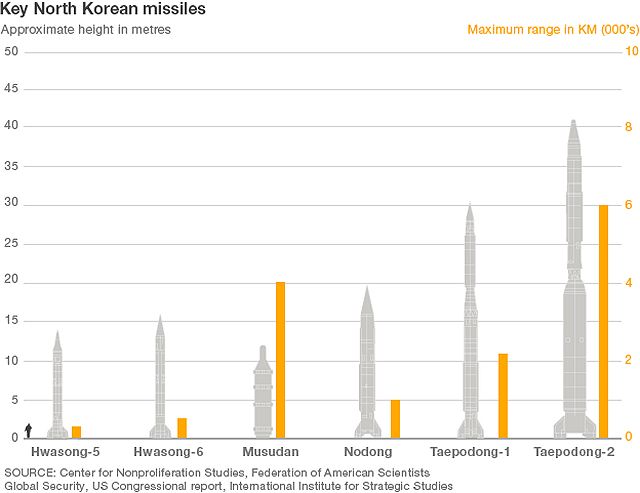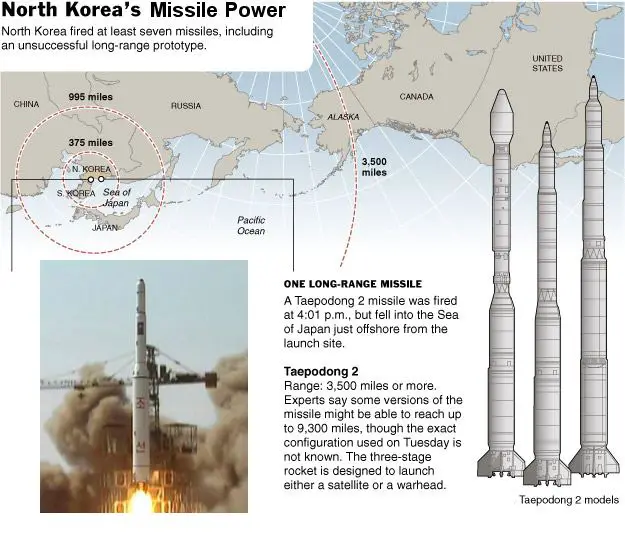The Missile power of North Korea able to strike South Korea but also United States 1705131
| a | |||
Missile power of North Korea |
|||
| Friday, May 17, 2013, 10:00 AM | |||
| The Missile power of North Korea able to strike South Korea but also United States. | |||
North
Korea is believed to have more than 1,000 missiles of varying capabilities,
including long-range missiles which could one day strike the US. Pyongyang's
programme has progressed over the last few decades from tactical artillery
rockets in the 1960s and 70s to short-range and medium-range ballistic
missiles in the 1980s and 90s. Systems capable of greater ranges are understood
to be under research and development. |
|||
| |
|||
 |
|||
| |
|||
South
Korea’s state-run Korea Institute for Defense Analyses (KIDA) said
that in line with a report submitted to the US Congress by the Pentagon,
North Korea has probably accumulated up to 200 so-called transporter erector
launchers (TEL), including up to 100 for short-range Scud missiles, 50
for medium-range Nodong missiles and 50 for long-range Musudan missiles,
the Yonhap news agency reported. Hwasong-5: The
Hwasong-6
is a tactical ballistic missile manufactured by the defence industry of
North Korea. The first of three successful test firings of the Hwasong-6
was reported to have been completed in June 1990. This missile is based
on the technology of Russian-made Scud-C. |
|||
 Hwasong-13 short-range ballistic missile |
|||
In the late 1980s,
North Korea has launched a programme to designe and maunuacture new
medium range ballistic missile known as the Nodong series which ahas
a rnage of 1,000 km, able to target Japan. The missile is based on the
Scud-D design, but is 50% larger and has a more powerful engine. The No-Dong-B
(BM-25 Musudan) is a medium range ground-to-ground ballistic missile
based on the technology of the Russian-made ballistic missile Scud-C.
The system was developed by the North Korean defence industry and was
unveiled for the first time to the public during a military parade on
10 October 2010 celebrating the Korean Worker's Party's 65th anniversary.
|
|||
 No-Dong-B medium range ballsitic missile |
|||
The
next steps in North Korean missile development are the Taepodong-1 and
Taepodong-2 (known as Paektusan in North Korea. The Taepodongs are large liquid-fueled missiles. As currently configured, they are operated like space launchers, with long assembly times, and launched from fixed, above-ground launch pads. A one ton payload of chemical or biological agent could have a much broader effect and the accuracy of the missile is far less critical. North Korea is known to have the ability to produce both chemical and biological agents. Taepodong-1: The Taepodong-1 also named Paektusan-1 in North Korea, is the the first local-made multi-stage missile. It has an estimated range of 2,200 km, but is understood to be even less accurate than the Nodong. The Taepodong-1 has been test flown only once on 31 August 1998 as a space launcher; instead of a normal ballistic missile payload, the missile carried a third stage, probably solid fuel, that was meant to inject a small satellite into low Earth orbit. Taepodong-2: Estimates of the performance of the Taepodong-2 are much more speculative. The Taepodong-2 - or Paektusan-2 - is also a two to three-stage ballistic missile, but is a significant advance on the Taepodong-1. Its range has been estimated at anything between 5,000-15,000km. Before December 2012, Taepodong-2 and its technology had been flight tested three times, in 2006, 2009 and April 2012. It failed to perform on all these occasions. |
|||
 Taepodong-2 intercontinental ballsitic missile |
|||


























